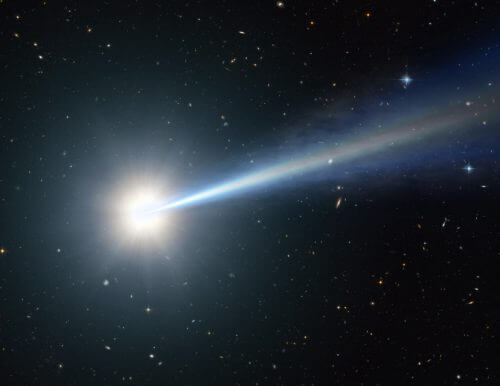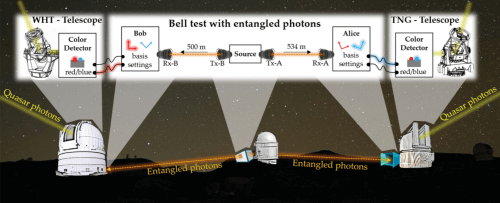Physicists from MIT and Vienna used distant light sources to prove that photons created in the lab are indeed entangled

Last year, physicists from the MIT Institute of Technology and the University of Vienna presented high-certainty measurements of quantum entanglement. This phenomenon, which sounds for the first time as if taken from fiction, binds two particles so that the distance and time between them do not play a role. Let's assume for a moment that there are two intertwined particles, each at one end of the universe (as far as an edge universe can be defined), the measurement of particle A will affect the measurement of particle B immediately, even if the distance between them is huge. Einstein of course did not like the idea and to disprove this principle he proposed thought experiments that did not match his expectations. In the XNUMXs, the scientist John Bell calculated what would be the theoretical limit beyond which the correlation (the degree of compatibility) between two particles must be explained on the basis of quantum theory, but what if this is not the case? These "what if" questions push physicists to test how successful a theory is or not. Bell's idea is based on a number of assumptions, one of which states that the system must be free of "free parameters", meaning that the measurement system must not depend on any parameter/factor and must be performed randomly.
To rule out the possibility that the measurement system's arrangement affects the result, MIT physicists used light pulses originating 600 light-years from Earth to select how the system measures the entangled photons created in the lab. In such an experiment, the assumption that the source of the correlation between the two photons is classical (that is, not quantum), forces the correlation mechanism to be created 600 years in advance, even before the entangled photons were emitted and even more before the laboratory was established and the measurement was performed. Now, in an article published in Physical Review Letters The same researchers assigned the conditions for Bell's principle and measured the photons from distant quasars, one 7.8 billion years old and the other 12.2 billion years old. They discovered that most of the photons were correlated in such a way that it crosses Bell's theoretical limit, which means that they are indeed quantum entangled.
"In the new experiment, if the correlation between the photons is maintained by a non-quantum mechanism, the mechanism had to have started 12.2 billion years ago - before such an experiment was even thought of, even before the Earth. This of course does not make sense, and therefore we can testify that this is essentially a quantum process and that the photons created in the laboratory are indeed intertwined," said one of the authors of the article. "The age of the Earth is about 4.5 billion years, therefore a non-quantum mechanism had to start even before the Earth existed," added David Kaiser.
A decision made billions of years ago
In 2014, Kaiser and two other researchers proposed an experiment that would create two entwined photons on Earth - a process that is certainly simple to perform in research laboratories around the world. After the entangled photons were created, the researchers planned to launch them in two opposite directions and measure their polarization, or in other words the orientation of the electromagnetic field from which the photon is constructed. With the help of the polarizer, the researchers could check the polarization of the photons and how much they "agree" in their polarization in each measurement. To show that a photon is entangled we must obey the assumptions of Bell's principle, one of which, as we have already mentioned, requires the researchers to remove free parameters. To do this, the team added another twist - light coming from a distant and ancient source, such as quasars, will determine the polarization angle we measure. If the light observed in a quasar is redder than some probing source, the polarizer will have a certain orientation. If the light is a little bluer than the source of the tester the polarizer will have a different orientation. In the previous experiments, the team used a simple telescope to measure the light from a star 600 light-years away. In the current study, the researchers used much larger and more powerful telescopes and through them they picked up light sources billions of light years away from us.

perfect timing
On 11.1.18 at 12 o'clock in the morning, the team members gathered at the edge of the mountain in the Canary Islands and began collecting the information from the powerful telescopes (4 meters in diameter) that are miles apart. Each telescope pointed at a quasar when they were at the laboratory station, the researchers created entangled photons that were each sent to one of the two telescopes. A fraction of a second before, a detector in the telescope determines whether the light oscillating from the quasar is bluer or redder than the probe source and accordingly calibrates the measuring device. "The timing is very tricky, everything has to happen in the same time window and be updated every micro second (millionth of a second)" according to Kaiser.
mirage vision
The experimenters ran the experiment twice, 15 minutes apart and with a different pair of quasars. In each run they measured thousands of entangled photon pairs. Immediately after the experiment, about a few hours after the telescopes were turned off, the researchers saw that there is a high correlation between the photons above the limit that Bell calculated, so it can be said that the particles are quantum entwined.
Guth, one of the editors of the experiment, explains that based on the experimental data, the chance that this is a classical mechanism and not a quantum one is one billionth of a billionth of a percent, meaning zero chance by all accounts. For comparison, the chance that the Higgs particle does not exist according to the results of the Sarn experiment is less than a billionth of a percent, "we showed that the chance of the existence of free parameters in the experimental system is zero".
And yet, there is a very small percentage that this claim is not true. To reduce the chance even more researchers are looking for sources far away from those measured now. Is it possible to use the cosmic radiation to test the interlacing according to the Bell condition? Not yet known.
More of the topic in Hayadan:

6 תגובות
12 at night is not yet morning...
Laws of life, nonsense in tomato juice, I had no idea that the scientists were so idiotic. For everything in the universe there is time and distance and time to move from point to point. God himself, who is part of our universe, God has a defined speed of movement in km/h and God has a time of years. God is made of very thin quantum matter that it will never be possible to measure the thickness of God one divided by ten to the twenty-fourth power. God moves from point to point within the space of the universe according to a time of about half the time of the movement of light which is known to move 300000 kilometers per second. The movement of light is faster than the movement of God. God himself is rarely found in any material in the universe and by the way our universe is isolated in space and there are no other universes or parallel universes at all. The quantum substance of God is found inside all the holes in the entire universe and is also found in every ray of light in the entire universe, but the fact that the divine substance is found in them at all does not mean black blacks are God nor does it mean that God is light. God is part of the universe and is a mathematical physical quantum frequency with built-in intelligence and the ability to concentrate his power and bring his divine power into action. In addition, God has physical and mathematical properties that God cannot explain these properties, and even if it were possible to explain them, human geniuses are not able to fully understand what God is. You have to be God in order to know or understand what God is.
Yosef
It is explicitly written that the light from the quasar does not have a single color:
"If the light observed in a quasar is redder than some probing source, the polarizer will have a certain orientation. If the light is a little bluer than the source of the tester, the pole will have a different orientation."
The purpose of the experiment is to lower another parameter: the researchers' determination of which polarization to choose.
layman
The idea is to increase the randomness in choosing the direction of the polarizer. To show interlacing, you have to show that a random choice of a polarizer on one side affects the other side. The quasar is used for the purpose of the experiment as a random source, in the following sense: there is no way to determine the color of the next photon from the entire sequence of photons we received. After all - the color of these photons was female billions of years ago.
Matters in my estimation because the more distant the source is, the more it is considered a point source. In addition, it is important that it be monochromatic - one color and coherent - a uniform wave front. That is, like a laser pulse. Quasar probably because of the intensity of the radiation,
I don't know if he is coherently monochromatic, but he is like a loser - to the arena, so it may be so.
Akhdad - Bell proposed an experiment that would test whether the system has quantum correlation or not. The quantum idea avoids the possibility that there are variables or parameters that we cannot measure that affect the experiment. We will add that we know that information must move at most at the speed of light (and we can talk about interweaving in this matter and claim that interweaving does not break locality, but this is a different article). Therefore, if you ignore quantum theory and believe in the free parameters, light that was created 12.2 billion years ago, reaches the earth and affects the experiment so that its result shows that the photons in the laboratory are highly correlated, indicating that that light somehow knew that the experiment would take place on the earth the moment it was created and had to take place so that the result of the experiment would be like that. Logic says that there is no possibility for a particle to be created based on an experiment that will be done 12.2 billion years later with some free parameter that will affect the experiment and hence it can be said that the experiment is free from free parameters and the entanglement must be quantum (up to some error). The more distant photons are chosen, the lower the probability that they were created within the knowledge of the experiment on Earth. Of course, the principle of full determinism cannot be completely ruled out, but the deeper we go into the experiment, the closer we get to it.
Can you explain about:
The same researchers assigned the conditions for Bell's principle and measured the photons from distant quasars, one 7.8 billion years old and the other 12.2 billion years old. They discovered that most of the photons were correlated in such a way that it crosses Bell's theoretical limit, which means that they are indeed quantum entangled.
What does it matter what the source of the photons is if the measurement is carried out in telescopes, and the interweaving is between two measurement systems, the telescopes?